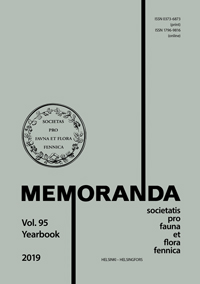The taxonomy and invasion status assessment of Erigeron annuus s.l. (Asteraceae) in East Fennoscandia
Abstract
A common European weed of North American origin, Erigeron annuus s.l. was described by Linnaeus on the basis of plants cultivated at de Hartecamp near Haarlem, the Netherlands. This species was originally introduced to Europe from the territories along the Saint Lawrence River, south-eastern Canada, between 1623 and 1633, in the garden of Jean and Vespasien Robin in Paris. The original plants belonged to the white-flowered taxon with crenate leaves and long spreading pubescence, which has been known in Europe as E. annuus subsp. septentrionalis. By lectotypification this taxon should be called E. annuus subsp. annuus, whereas the lilac-flowered taxon with coarsely dentate leaves and long erect pubescence (previously known as E. annuus subsp. annuus) is redescribed here as E. annuus subsp. lilacinus Sennikov & Kurtto, subsp. nov. Three alien taxa of E. annuus s.l. are recognised in East Fennoscandia, including E. annuus subsp. strigosus; they are assessed as locally established but not invasive in Finland, and only casual or possibly extinct in the Russian part of East Fennoscandia. The original and still prevailing pathway of introduction is gardening or agriculture, whereas in the latest years the plants were also introduced through the transport of goods (southern fruits and vegetables in Russia for E. annuus subsp. lilacinus; Russian timber in Finland for E. annuus subsp. strigosus). The nomenclature of Erigeron sect. Phalacroloma and E. sect. Stenactis is revised; the latter name is reinstated in place of E. sect. Polyactis G.L.Nesom, nom. illeg. Erigeron sect. Stenactis sensu Nesom is renamed as E. sect. Pumili (Rydb.) Sennikov, comb. nov.




